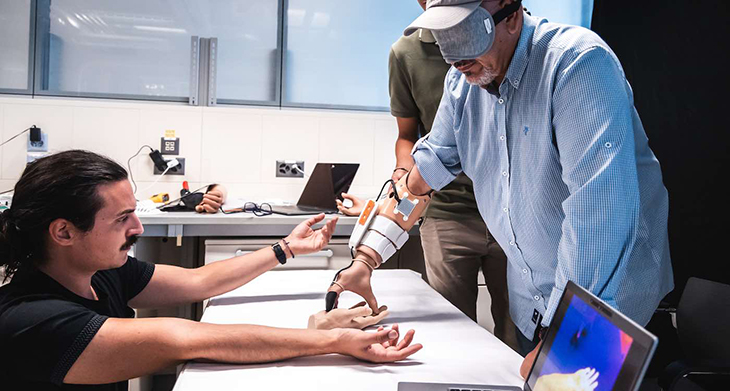
Researchers have achieved a remarkable feat in prosthetic technology, unveiling the world’s first artificial limb capable of sensing temperature and transmitting the sensation of warmth.
The innovative MiniTouch device offers hope for amputees, granting them the ability to perceive and respond to temperature changes, potentially enhancing their social connections.
MiniTouch functions by relaying thermal information from the prosthetic fingertip to the wearer’s residual arm. This groundbreaking technology has been tested on a man in Italy who lost his hand three decades ago. Remarkably, he demonstrated 100 percent accuracy in distinguishing between hot and cold objects using the device.
Scientists from Italy and Switzerland envision broader applications for MiniTouch, aiming to restore a full spectrum of sensory experiences through prosthetics. The device provided realistic and instantaneous thermal feedback to a 57-year-old amputee from Pistoria, offering him the long-awaited sensation of warmth from another person after 37 years.
Fabrizio, the recipient of MiniTouch, expressed overwhelming emotions upon feeling the warmth of another individual, an experience he had been deprived of since his amputation.
“It was a very strong emotion for me. It was like reactivating a connection with someone.”
Moreover, MiniTouch empowered him to discriminate between objects of varying temperatures and materials with precision. (You can see this in the video from Reuters below…)
“When one of the researchers placed the sensor on his own body, I could feel the warmth of another person with my phantom hand,” said Fabrizio.
This breakthrough technology, documented in a study published in the journal Med, marks a significant milestone in prosthetic innovation. For the first time, natural temperature sensations have been integrated into a functional artificial limb, representing a frontier in the quest to restore tactile sensitivity to robotic hands.
Professor Silvestro Micera, a joint senior author of the study from the Sant’Anna School of Advanced Studies, reported, “For the first time, we’re really close to restoring the full palette of sensations to amputees. And it can be easily integrated into commercial prostheses.”
MiniTouch distinguishes itself by its accessibility and simplicity. It utilizes off-the-shelf electronics integrated into commercially available prosthetic limbs, eliminating the need for invasive surgical procedures. Instead, the device is attached to a specific point on the wearer’s limb, stimulating sensations in their phantom index finger.
During clinical trial conducted at the Inail Prosthesis Centre in Vigorso di Budriothe, Bologna, Italy, it was demonstrated that Fabrizio could accurately differentiate between three similar bottles containing water at different temperatures (12°C, 24°C, and 40°C).
Additionally, the device enhanced Fabrizio’s capacity to swiftly categorize metal cubes based on their varying temperatures.
Dr. Solaiman Shokur, co-author from the École Polytechnique Fédérale de Lausanne (EPFL) in Switzerland said, “When you reach a certain level of dexterity with robotic hands, you really need to have sensory feedback to be able to use it to its full potential.”
“We think having the ability to sense temperature will improve amputees’ embodiment—the feeling that ‘this hand is mine’.”
Jonathan Muheim from EPFL, a co-author of the study, emphasizes the importance of incorporating thermal sensations into neuro-prosthetics, highlighting their relevance in everyday life. Moving forward, the MiniTouch team aims to expand the device’s capabilities by integrating thermal information from multiple points on an amputee’s limb.
The ultimate goal is to develop a multimodal system that seamlessly combines touch, perception, and temperature. This advanced system would be able to tell the user ‘this is soft and hot’, or ‘this is hard and cold’. Prof. Micera concludes it’s all to offer a “richer and more natural perception of the tactile world.”
See this incredible invention for yourself in the video below.



